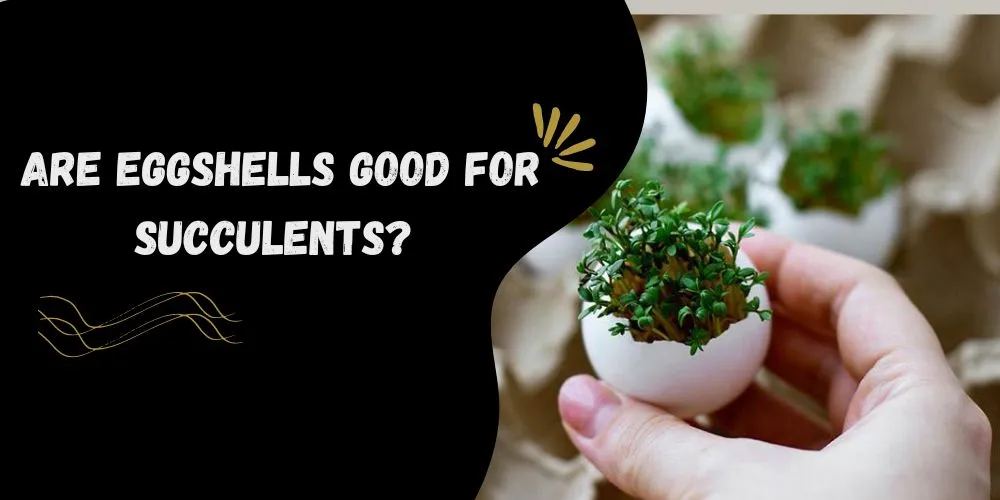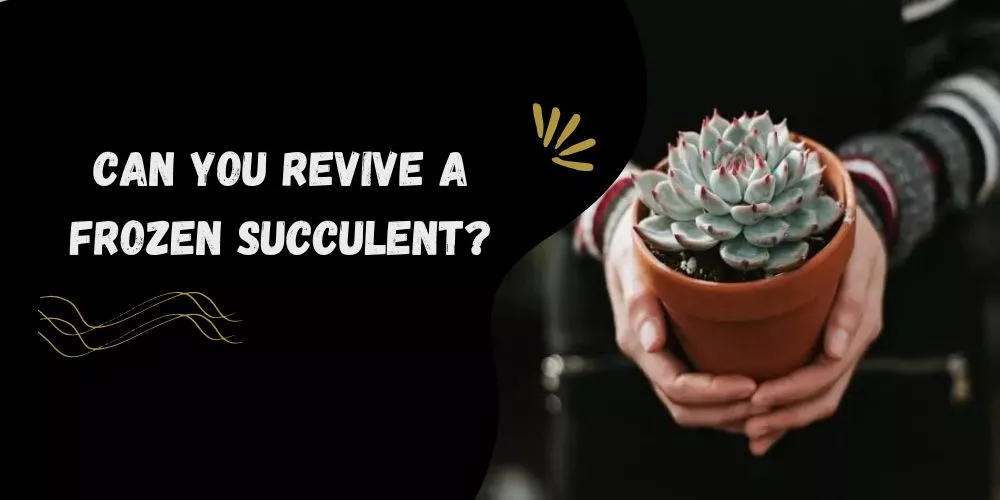Plants having thickened, fleshy, and glutted parts retaining water in dry climates or soil conditions are known as succulents. The succulent word originated from the Latin word ‘sucus’ meaning ‘juice’ or ‘fluid’.
Water stored by succulent plants may be in the leaves and stems. Some organs of succulents are known to have up to 90 to 95% of water content. The unique and distinctive appearance of succulents perceive them as decorative plants and often find a place in the living room or outdoor garden terrace adding value to the aesthetics.
However, succulents can sustain and grow with minimum care. If that’s true, then can you leave succulents outside as well?
Well, yes you can leave succulents outside if it’s not raining very heavily or too cold. So in all the normal weather conditions you can leave them outside and they will take care of themselves, but in harsh conditions you should bring it back to indoors.
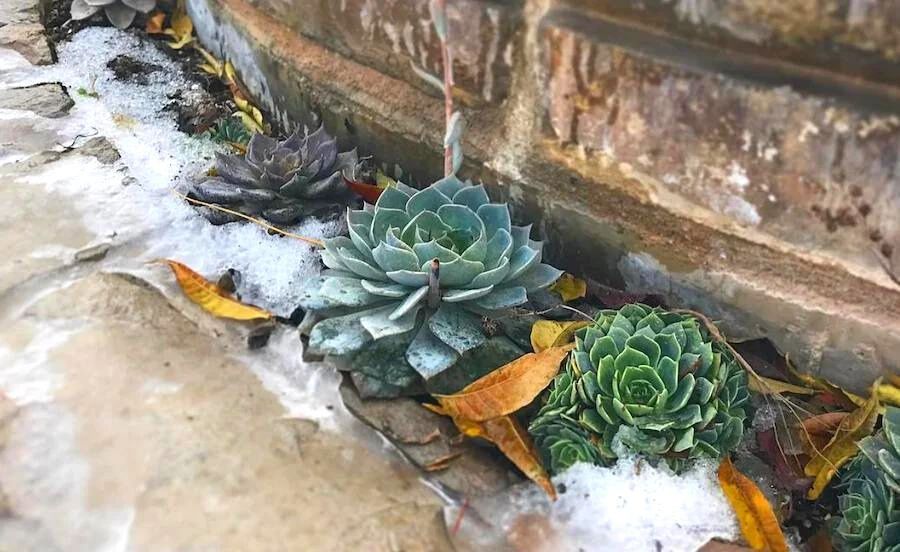
When Not To leave succulents outside?
There is no harm in leaving the succulents outside, as they are rigid in sustaining any kind of climate and need little or no care. But there are certain situations for some species you may need to consider and bring them indoors before it is too late.
Avoid keeping them outside in the following situations:
- In the winter season, if the temperature drops below 40F.
- In a heavy rainfall location.
- In an area where humidity crosses 50%.
Can You Leave Succulents Outside?
The simple answer to this question is yes. Succulents can grow in locations with bright sunlight and warm and dry climates and can tolerate adverse climatic conditions. Succulents can be grown in the open ground in soil or in pots. They can survive in any situation.
Succulents don’t need personal care regularly. They can sustain themselves even if neglected for a long time. Planting the succulents in nitrogen-rich soil will benefit them to grow.
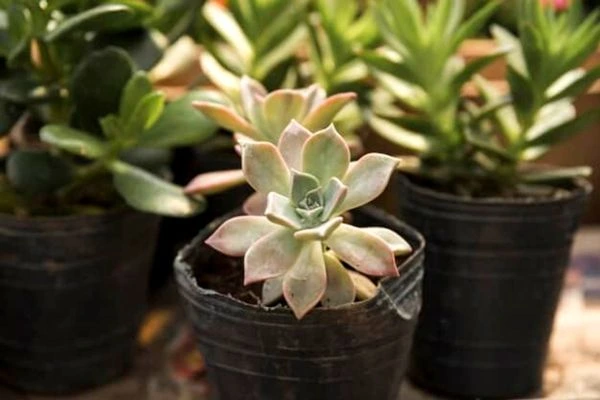
Most succulents require water and fertilizer in moderate quantities. What they need more is plenty of sunlight. Well-drained sandy and loose soil are considered best for the growth of succulents. Succulents thrive well in a relatively low humidity area.
Acidic soil has a pH of approximately between 6.0 to 6.5 fine for succulents. On the other hand, alkaline soil may kill the plant.
The tough succulent plants may resist the freezy winters in pots or the open ground provided with well-drained soil, and the plants get protection from severe conditions and severe dips in the temperature.
Should Succulents be Kept Inside or Outside
Succulents are customized to be grown outdoors. Due to their resilient nature, they can survive in many adverse situations like scarce water, fast-draining soil, and harsh sunlight. If you live in an area that is supposed to be ideal for succulents, you can plant them outside.
But, some succulents are not rigid to some climatic scenarios. You need to be concerned with some situations, such as winter, rain, or humidity, where some conditions may harm your succulents.
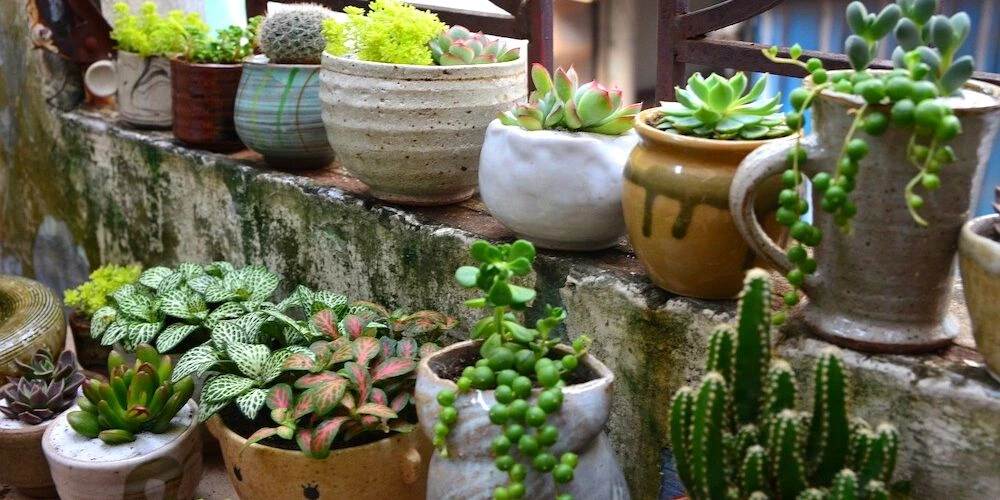
Winter
In the case of overly cold temperatures below 40 F, some species of succulents may not be able to resist the harshness of the weather and go dormant. Below 40 F, the water stored in these plants may freeze and rot the plant.
To avoid these, you can temporarily move the succulents indoors and wait till the temperature gets ideal for the succulents.
Rain
If you live in an area of heavy rainfall, you should be careful of your outdoor succulents. Succulents enjoy soaking water from the moist atmosphere or the soil, but too much water may cause fungi infestation or invite pests to rot the roots. Tender succulents like Crassula, Echeveria, or Kalanchoe, are the most affected varieties.
In this scenario also, you may try to protect the succulents by sheltering them or moving them indoors.
Humidity
Be alert if you live in an area of high humidity. Succulents are happy with 30-40% humidity, but excess humidity can be a problem similar to those caused by heavy rains. You should check and regulate the watering of succulents accordingly.
If you notice extreme humidity, you should simply try to dry the soil on which the succulent has grown, as it is getting enough water from the moist climate. If you wish to keep the succulents outside, irrespective of all the climates here is what you can do:
- During winters, you should protect the plants from too cold temperatures by setting up an arrangement to prevent the water from the plants from getting frozen.
- In case of heavy rains, if you already have built a shelter, the heavy rainfall won’t affect your plants. Just check whether the soil doesn’t remain wet all the time, which may rot the roots and harm the plant.
- If the climate is excessively humid, try keeping the soil as dry as possible.
How to Grow Succulents Outside in a Proper Manner?
There may be several reasons for growing succulents outside. It may be the availability of an open area outside the house, or you want to add some decorative plants to your existing garden. Whatever the reason, we have tips for you to grow succulents properly.
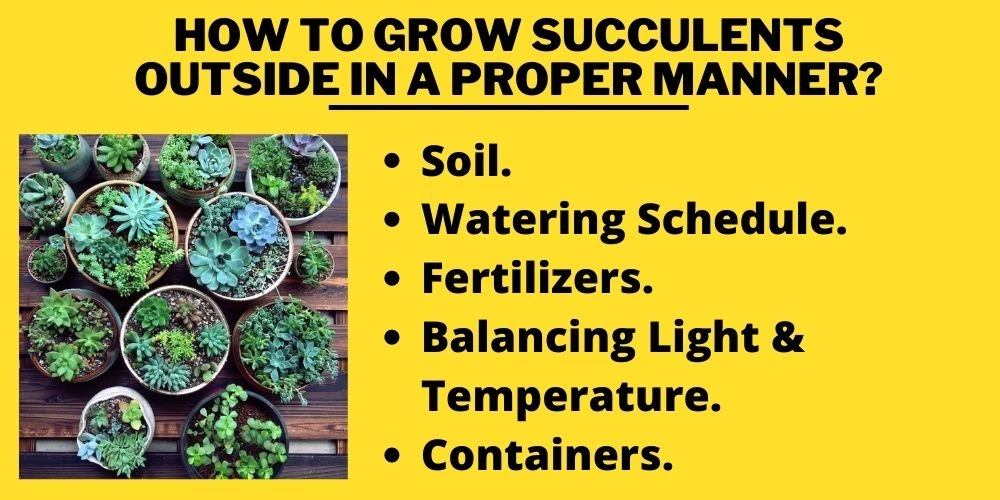
Let’s go through all the points one by one.
1. Soil
Let’s find out the best soil for your succulents when you plan to grow them outside. Succulents planted in an ideal soil composition will keep them healthy. You should look for a soil having a good capacity for draining water, as it will complement the growth of your succulents due to their shallow roots.
Check for a loose, rocky solid rich in nutrients for the best growth of your succulents.
If you plan to plant succulents in a pot, you should look for potting mix customized for succulents and ensure the pot has holes at the bottom to drain the water. Ensure the soil is acidic at a 6.0 to 6.5 pH value, as alkaline soil may be risky for your succulents.
2. Watering Schedule
Do you understand one myth from all the others we all believe? And this is that the more we water the plants, the more it will benefit them. But that’s not helpful. Over-watering may be dangerous, especially for succulents.
Let’s understand some water scheduling tips to help your succulents grow ideally.
- To help succulents survive in cold weather, decrease the level of watering.
- Ensure your soil is not too saturated, which may be risky for succulents during winter.
- Watering should be deep but at long intervals when the plant is growing.
- The potting mix should be thoroughly saturated, and drain the extra water. Later ensure to dry out the mixture before the next watering session.
- Maintain a frequency of watering your succulents once a week.
- Place the succulents on the drier side of your area.
- If you notice plants looking lanky or withering leaves, you should test the soil to check the dryness, then water it to reach the ideal saturation level.
- Maintain the perfect level of soil wetness as too much moisture in poorly drained pots may rot the roots of succulents.
3. Fertilizers
Though succulents don’t require anything extra to survive, nourishing them with fertilizers will boost their growth.
4. Balancing Light & Temperature
Bright sunlight helps the ideal blossoming of succulents. Poor sunlight will force the succulents to reach for sunlight clunkily, which results in them growing as thin and unbalanced plants.
The tough succulent variants may resist extreme cold climatic conditions provided they are planted in well-drained soil and are protected from severe temperatures.
The delicate succulent variants may not be able to resist harsh climatic conditions, and they need to be brought indoors for their survival. You can place them near a window exposing them to sunlight.
5. Containers
You can plant succulents in open ground. But it’s ideal planting them in containers. Due to their nature to survive in odd conditions, planting them in a container won’t be a hindrance to their growth.
You can move containers throughout the area and whenever you want to bring the plants inside, they can be brought in effortlessly.
Does Rain Affect Succulents?
In case of a moderate rate, there won’t be any effect on your succulents. On the contrary, it will wash away all the filth and chemicals from the soil, providing nitrogen to the succulents.
Areas having 20-25 inches of annual rainfall are of no harm to the succulents, even if planted in an open garden. But heavy and frequent rains may be a thing you need to worry about, and you should be extra vigilant in such scenarios. Let’s find out some care tips you need to take if you receive heavy rains.
Tips To Protect Succulents From Heavy Rain
There are some simple tips to follow to protect succulents from heavy rain.

Use a Protective Cover/Shield
You can always keep the plants under shelter to prevent rainwater reach them, keeping the plants dry and soaking only the required moisture from the weather. Avoid water plants during heavy rain as it will be excess for the succulents.
Use High-Quality Well-Draining Soil
You can prepare well-draining soil by mixing two parts of sand and gardening soil with one part of High-Quality Pumice or perlite. The presence of pumice or perlite is to help in drainage and aeration.
Provide Proper Air Flow
You will need to ensure the succulents placed indoors receive adequate airflow. If you have a well-ventilated room and the exchange of outside air with indoor air frequency is good, you can put the succulent near a window. But, on the safer side, you should consider placing a fan near your plant to prevent it from being deprived of the airflow it deserves.
Frequently Asked Questions (fAQs)
1. Can succulents be left outside overnight?
Yes, they can be left outside overnight in average climatic conditions. But should be brought indoors in case of harsh climatic situations.
2. Can you leave succulents outside in the winter?
As far as the temperature is not less than 40F it’s ok, but if it drops below 40F, it’s better to bring them indoors.
3. At what temperature do you need to bring succulents inside?
When the temperature drops below 40F, you need to bring them inside.
Conclusion
Succulents are plants that can grow with less water and zero fertilizer. All it needs is plenty of sunlight. The name succulent originated as it stores water in its stems and leaves.
The appearance of succulents is attractive and pleasing to the eyes. Therefore they are used as an ornamental plants indoors or in gardens.
If you love to plan succulents, you should look after them to give them healthy and ideal growth. Some plants need attention during severe climatic conditions.

